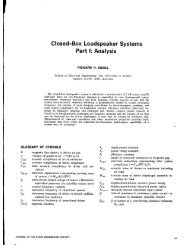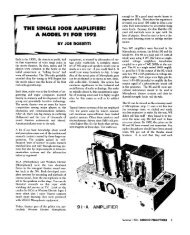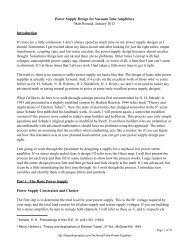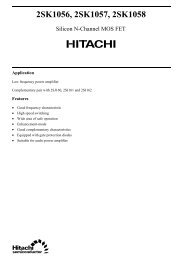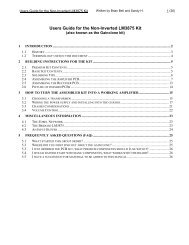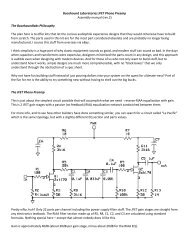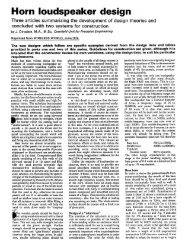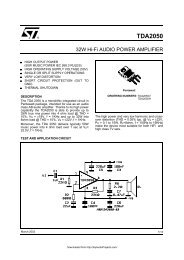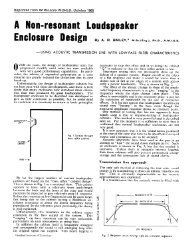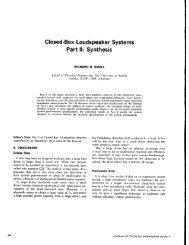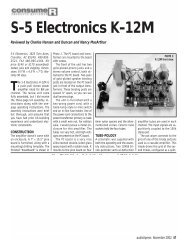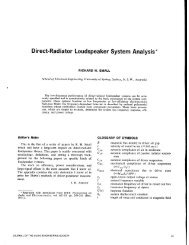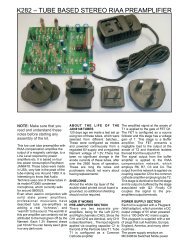A Model of Open-Baffle Loudspeakers - DIY Audio Projects
A Model of Open-Baffle Loudspeakers - DIY Audio Projects
A Model of Open-Baffle Loudspeakers - DIY Audio Projects
You also want an ePaper? Increase the reach of your titles
YUMPU automatically turns print PDFs into web optimized ePapers that Google loves.
0 Abstract<br />
A <strong>Model</strong> <strong>of</strong> <strong>Open</strong>-<strong>Baffle</strong> <strong>Loudspeakers</strong><br />
Juha Backman<br />
Nokia Mobile Phones<br />
P.O. Box 100<br />
Nokia Group<br />
Finland<br />
E-mail: juha.backman@nokia.com<br />
The open-baffle loudspeaker is, although structurally very simple, a challenge for modelling. This<br />
paper presents a computationally efficient model for predicting the frequency response and the<br />
polar pattern <strong>of</strong> an open-baffle loudspeaker. The baffle is modelled using time-domain geometrical<br />
theory <strong>of</strong> diffraction, and the conventional driver model is complemented with simple additions to<br />
approximate the acoustical asymmetry <strong>of</strong> the structure.<br />
1 Introduction<br />
<strong>Open</strong>-baffle loudspeakers are the longest-known1 and structurally simplest loudspeakers, but they,<br />
at the same time, pose considerable theoretical challenges for the modelling. A simple dipole model<br />
partially explains some <strong>of</strong> their features, but such a model is valid only at very low frequencies, and<br />
the parameters <strong>of</strong> the model (e.g. the effective size <strong>of</strong> the dipole) are difficult to determine. The<br />
simple dipole model fails in several respects: it is impossible to take into account asymmetry and<br />
other baffle shape effects, the mid-frequency polar pattern is not predicted correctly, etc. Thus<br />
taking into account both driver properties and baffle geometry is needed.<br />
The open-baffle speakers do, in addition to being theoretically interesting, have some practical<br />
importance. Dipole loudspeakers (and other gradient loudspeakers) provide a constant directivity<br />
also at low frequencies. They also excite fewer low-frequency room modes (although the benefit <strong>of</strong><br />
this is not self-evident) and their acoustical power output is affected by side boundaries much less<br />
than the output <strong>of</strong> omnidirectional speakers*.<br />
Despite these advantages the open-baffle speakers are far from being ideal wo<strong>of</strong>ers. Their wellknown<br />
practical problem is their inability to produce adequate low-frequency output. This is a<br />
problem particularly with electrostatic and ribbon units (which otherwise are not being discussed<br />
within this paper), where the displacement is limited, and there is a trade-<strong>of</strong>f between the<br />
displacement and the sensitivity. Larger volume velocities can be achieved by using dynamic<br />
wo<strong>of</strong>ers, but to maximise their output, a baffle is needed around the driver. The low frequency<br />
(dimensions (( a) output <strong>of</strong> a dipole is proportional to both the volume velocity and the linear<br />
dimensions, so doubling the baffle size equals doubling the displacement. This baffle in turn creates<br />
’ HUNT, FREDERIK V.: Electroacoustics. The Analysis <strong>of</strong> Transduction, and Its Historical Background. Harvard<br />
University Press, 1954; reprint Acoustical Society <strong>of</strong> America, 1982, pp. 86 - 87.<br />
* MORSE, PHILIP M.; INGAARD, K. UNO: Theoretical Acoustics, McGraw-Hill, Inc., New York, 1968; reprint Princeton<br />
University Press, Princeton, 1986, pp. 372 - 375.<br />
1



